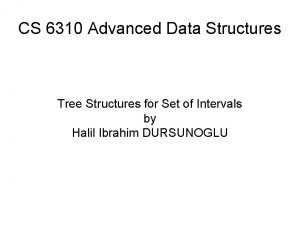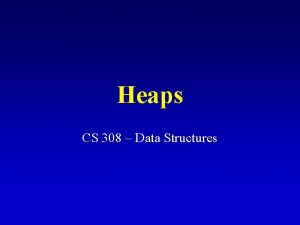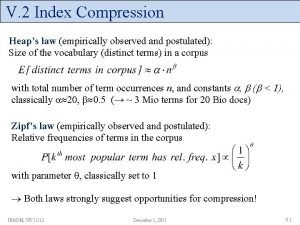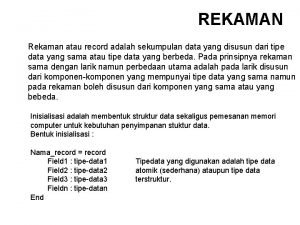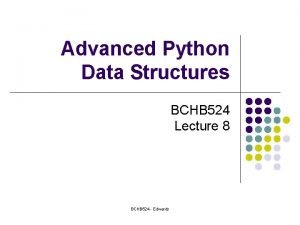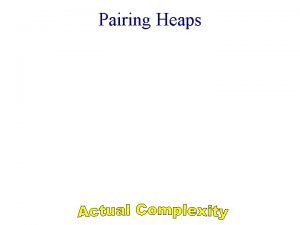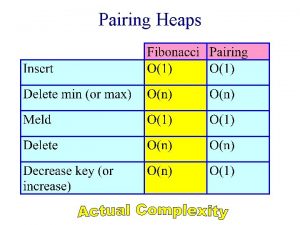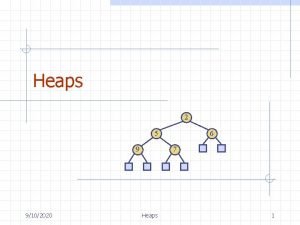HEAPS CS 6310 Advanced Data Structure WeiShian Wang


















- Slides: 18

HEAPS CS 6310 Advanced Data Structure Wei-Shian Wang

� Also called priority queues � Support operations: insert, find_min, delete_min � Min-heap and max-heap

5. 1 Balanced Search Trees as Heaps

� insert : O(log n) � find_min : O(log n) O(1) � delete_min : O(log n)

Make find_min in O(1) � Store � Look the current minimum in a variable up the new current minimum in O(log n) time when we perform the next delete_min

� delete_min – O(1) 1. Delete the object current_min->object 2. Move current_min to the next list position 3. If current_min->key is now larger than the key in the root of the balanced tree, add the left subtree of the balanced search tree to the invalid nodes structure; take the right subtree as new search tree; and return the node of the old root to the free list 4. Return several nodes from the invalid nodes structure to the free list


� insert – O(log n) 1. Split the search tree at current_min->key, and add the lower tree to the invalid nodes structure 2. Insert the new key in search tree 3. If the key is below current_min->key, set current_min to the new key and object � find_min – O(1) • Return current_min->key and current_min ->object

� Theorem. The heap structure can be realized using a balanced search tree with lazy deletion in time O(log n) for insert and O(1) for find_min and delete_min operations if the heap contains n element.

5. 4 Leftist Heaps

Leftist Heap Properties � Each node contains an additional field, the rank, which is defined by Ø n->rank = 1 if n->left = NULL or n->right = NULL Ø n->rank = 1 + Min(n->left->rank, n->right->rank) if n->left ≠ NULL and n->right ≠ NULL � Heap is empty if root->rank = 0

� Each node in a leftist heap has the shortest path on the left side is at least as long as that on the right side: Ø n->left->rank ≧ n->right->rank � If they are not both defined, then if one of them exists, it is the left one: Ø n->left = NULL only if n->right = NULL � Most � All nodes are on the left the merging work is done on the right


� insert Ø O(log n)

� delete_min Ø O(log n) and merge

� Theorem. The leftist heap structure supports the operation find_min in O(1) time and insert, merge, and delete_min in O(log n) time

� Leftist Heap Visualization Ø https: //www. cs. usfca. edu/~galles/visualizatio n/Leftist. Heap. html

Thank you !
 Navmed 6310/1
Navmed 6310/1 6310
6310 Stack is a static data structure
Stack is a static data structure Heaps of love
Heaps of love Binomial heap delete min
Binomial heap delete min Skew heap
Skew heap Heap or pile - they are puffy
Heap or pile - they are puffy Fibonacci
Fibonacci Reheap up
Reheap up Tom heaps
Tom heaps Soft heaps of kaplan and zwick uses
Soft heaps of kaplan and zwick uses Heaps law example
Heaps law example Advanced higher modern studies essay structure
Advanced higher modern studies essay structure Rekaman data
Rekaman data Azure secure enclave
Azure secure enclave Advanced data structures in java
Advanced data structures in java Btm 382
Btm 382 Advanced field artillery tactical data system (afatds)
Advanced field artillery tactical data system (afatds) Advanced data structures in python
Advanced data structures in python

